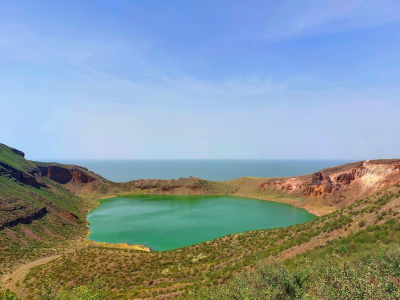Lake Turkana

The Lake Turkana National Parks provide an important stopping point for migratory birds and holds fossil and geological records that have brought an understanding of its paleo-environment.
The parks consist of Sibiloi National Park and two islands on Lake Turkana (South Island and Central Island). They contain both animal and hominid fossils in the Koobi Fora deposits which are unique in the world. The parks also are a breeding ground for the Nile crocodile, hippopotamus, and snakes.
Community Perspective: more romantically known as the Jade Sea, the area is characterized by a constant fight for survival against drought and starvation.
Map of Lake Turkana
Community Reviews
Richard Stone

Visited September 2005.
As I was born in Kenya, it holds a special place in my heart. The Northern Frontier District or NFD has always been seen as a very wild place and certainly not for the faint-hearted to visit.
Lake Turkana itself has gone by many names, initially Lake Rudolph and the more romantic Jade Sea.
Life for the local tribes people is a constant fight for survival against drought and starvation. Camels and goats are the only animals able to survive these conditions.
Lake Turkana is absolutely huge and you could spend many weeks traversing its shores. Of particular interest to the adventurous soul are the Volcanic islands which have their own lakes within them. Hiring a reliable boat is essential as it gets very rough out on this mini sea.
Also of great interest to human history are the archaeological finds that have been made along its eastern shore.
Finally their are the immensely interesting tribes people who inhabit its shores. Regularly in conflict with one another over the limited resources available it is always good to keep abreast of travel advisories, and particularly in respect of somali incursions. Some of the local practices such as female circumcision may make you cringe and witch doctors still hold sway over modern medicine.
The best way to visit as we did, is with a small group of people led by an experienced guide/driver/mechanic.
If you want to see an Africa which is in most respects unchanged over millenia then this is the place to come. Combine your trip with a visit to Samburu and Marsabit and be amazed at the vistas that extend infinitely into mirages.
Read more from Richard Stone here.
Community Rating
- : SHIHE HUANG
- : Richard Stone
- : Gernot
- : Carlos Garrido
- : Atila Ege Eric Lurio
- : Zoë Sheng
- : HE SHAOMIN
Site Info
- Full Name
- Lake Turkana National Parks
- Unesco ID
- 801
- Country
- Kenya
- Inscribed
-
1997 - In Danger
- Type
- Natural
- Criteria
-
8 10
- Categories
- Natural landscape - Rivers, Wetlands and Lakes Paleontology - Non-hominid fossils
- Link
- By ID
Site History
2018 In Danger
Threats come from Dam in Ethiopia (already complete), plus sugar developments and the LAPSSETT project
2001 Extended
To include South Island National Park
2001 Name change
From "Sibiloi/Central Island National Parks" to "Lake Turkana National Parks"
1997 Deferred
Bureau - Need to sort out Natural aspects (Mammal fossils) from Cultural (Hominid) even though Kenya only nominated under natural criteria
1997 Inscribed
Site Links
Unesco Website
Official Website
In the News
Connections
The site has 29 connections
Damaged
Ecology
Geography
History
Individual People
Timeline
Trivia
WHS Names
WHS on Other Lists
World Heritage Process
Visitors
20 Community Members have visited.
The Plaque
No plaque has been identified yet for this site.